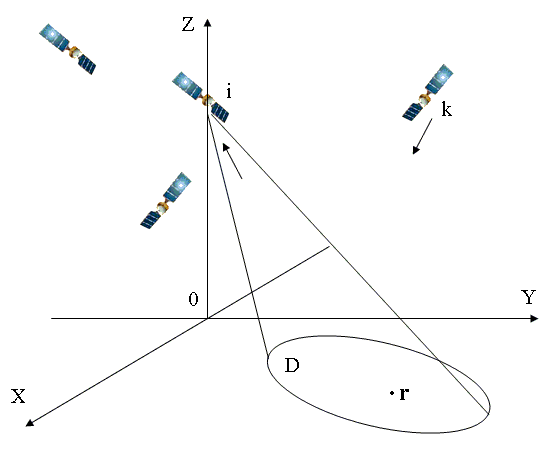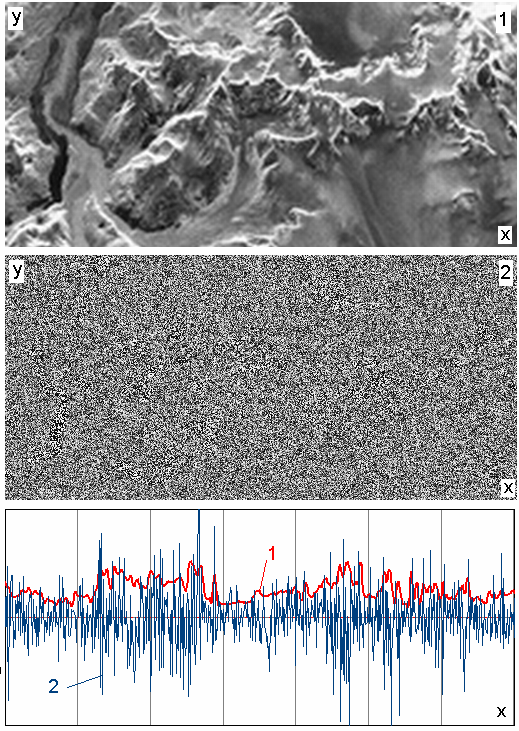|
|
Multiposition Synthetic Aperture Radar (MPSAR) Alexander V Ksendzuk |
| Main Page |
2. Multiposition SAR. Signal and surface models.
2.1. General signal model. Consider arbitrary bistatic pair inside multiposition SAR, Figure 2.1.
Figure 2.1. Spatial configuration of the multiposition SAR. |
| Signal Model | |
| Geometry | |
| Optimal Signal Processing | |
| Object detection | |
| Multiposition SAR interferometer | |
| Pseudonoise signals in remote sensing systems | |
| Pseudo-passive SAR | |
| Remote sensing systems modeling principles | |
| About Author | |
| Links | |
|
Signal
scattered from arbitrary points inside radar scene
where
Received signal in multiposition SAR is an addition of signals for different bistatic pairs i-th receiver, k-th transmitter
where each signal
An example of the signal, scattered from different surface point are shown in Figure 2.2.
Figure 2.2. Signals in bistatic pair inside MPSAR, scattered from radar scene. Input processes in each receiver are usually described as an addition of the scattered signal with noise, which usually may be described as delta-correlated Gaussian process with zero mean
Input process in multiposition SAR
is a vector
2.2. Functionally-determined surface models.
Reflected from the surface signal
has some variation in structure, these variations appear due to scattering
features of the surface. Accurate relations between received signal and surface
parameters may be derived by means of electromagnetic equations for the selected
surface model. In analysing the quantitative electromagnetic response of the
earth�s surface the relevant environmental factors must be considered to relate
measured parameters of the signal to the local surface�s electrophysical
parameters Usually these relations are given with the functional-deterministic surface models; with these models scattered form the surface electromagnetic field is represented as some function which depends on electrophysical parameters(large or small irregularities, representation of the surface as a set of facets, cylinders etc). 2.3. Stochastic surface models. Most of real surfaces can�t be described by some deterministic functions because of random behaviour of the electrophysical parameters. Therefore adequate description of such surfaces may be given within statistical theory. Lets call models of such surfaces stochastic. The most complete definition of the scattered signal may be given with multi-dimension probability density function. But determination of such characteristic usually impossible so it is inevitable to use some simplified scene models. One of the useful models is an assumption of the scene as a set of point independent scatterers with own scattering probabilities. Representation of the surface as a set of independent scatters, characterised by own reflection�s probability distribution, leads to gaussian character of the input process due to central limit theorem. So, with this surface model scattering coefficient is a discrete space random non-stationary process, covariance of which is changes due to radar cross-section variations:
where
Figure 2.3. Stochastic surface model, 2D image and cross-section. 1- radar cross section behaviour; 2- complex scattering coefficient (real part), simplified surface model. Conclusion. Input process and signal models are the keypoints in optimisation process. In multiposition SAR input processes in each receiver and its signal part (signal scattered from the surface) are presented. Scattered from the surface signal may be represented as stochastic or deterministic space-time process. This separation is defined by surface model. Stochastic and deterministic surface models are described.
|
| e-mail to author: Alexander V Ksendzuk |





